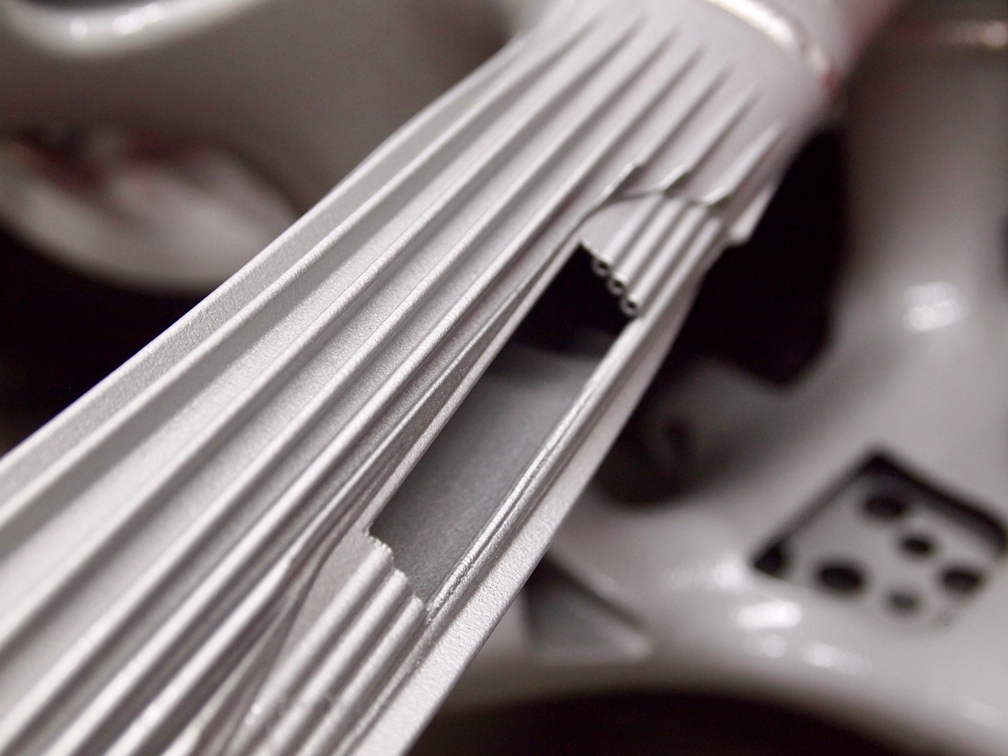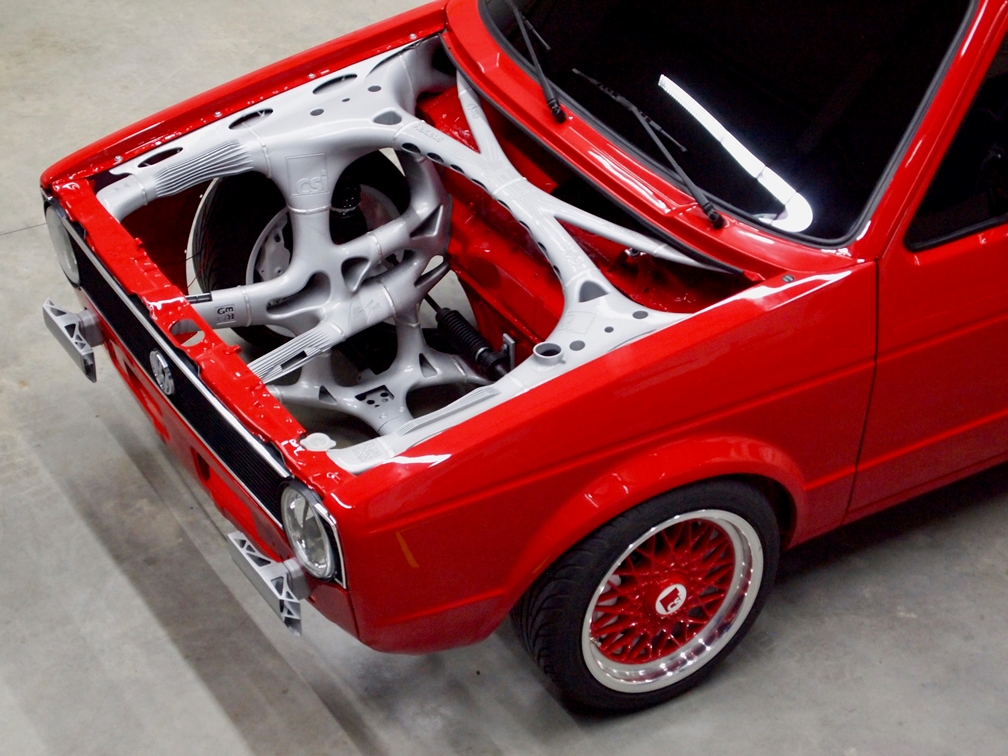CLASSIC CAR MEETS FUTURE TECHNOLOGY: VW CADDY FITTED WITH 3D-PRINTED FRONT-END STRUCTURE
Individualize, integrate, innovate: 3i-PRINT partnership project highlights the potential of industrial 3D printing
Altair, APWORKS, csi entwicklungstechnik, EOS GmbH, GERG, and Heraeus have used the front-end structure of a classic VW Caddy to demonstrate the full potential of industrial 3D printing within the automotive industry. The structure is very light, stable, and, at the same time, features a high degree of functional integration. In this joint development project known as 3i-PRINT, the involved companies covered every development step of the process, from design, simulation, optimization and manufacturing to post production of the part. From conceptual design to final vehicle, the project was completed in only nine months.
Value of additive manufacturing for the automotive industry
Driving innovation, impacting decisive development processes, over the next few years, industrial 3D printing, also known as additive manufacturing (AM), will play an integral role in large-scale manufacturing. The technology is already being deployed in a wide range of industries. The constant evolution of production and design techniques using AM will make the technology even more cost-effective and efficient in the future. In other words, the use of industrial 3D printing will continue to grow – also in the automotive industry. In order to drive innovation and decisively form development processes, it is essential to explore all possibilities in the fields of design and additive manufacturing today.
The true value proposition of additive manufacturing in automotive engineering can be realized only with considerations extending far beyond structural mechanics and lightweight construction. This functional integration –implementing as many technical features as possible with as few components as possible with the resulting added value, is an additional key advantage that makes the use of 3D printing lucrative for the automotive industry. With the Caddy concept, the 3i-PRINT project aims to demonstrate future technological possibilities.
Organic design for load-bearing structures
In view of the growing trend towards electrification in the automotive sector, for example of drive train and actuators, heat management as well as the reduction of design space and overall weight were crucial points when designing the front-end section. Moreover, structural requirements relating to vehicle safety, performance, and comfort needed to be addressed.
Accordingly, parts of the additively manufactured front are load-bearing structures that include details for both active and passive cooling – for example with a channeled airflow to cool batteries and brake systems. In addition, functions linked to heat management, passive safety, and fluids storage have been integrated in the organic, load-driven design of the front-end module. One example for the integration of additional functions into the structure is the fountain solution tank, which could be integrated into the front end structure when conducting the topology optimization.
Combined expertise along the process chain
With these goals in mind, the experts at csi entwicklungstechnik began designing, developing, and building the front end structure. The company develops high-quality modules for vehicle bodies, interiors, and exteriors for both manufacturers and suppliers in the automotive sector. GERG is a leading supplier of innovative solutions in the area of prototyping and small-scale series for the automotive and aerospace industries. In this project GERG was responsible for connecting the additively manufactures components and the creation of the final frame. With their focus on the development and broad application of simulation technology to synthesize and optimize designs and processes, Altair's software solutions were used to design, optimize, simulate, and develop the structure.
After the successful simulation and design of the concept, APWORKS took care of the final dimensioning of the components for 3D printing. APWORKS contributed its knowledge of print preparation and handled the actual additive manufacturing of the structural elements. As a subsidiary of Airbus, the company is very familiar with state-of-the-art manufacturing processes and enables various industries to implement best practice concepts from the aerospace sector. When printing the front end, APWORKS relied on a system developed by EOS, the leading technology supplier in the field of industrial 3D printing of metals and polymers. Metal powder specialist Heraeus supplied and qualified the high-strength aluminum alloy Scalmalloy®, developed by APWORKS, to manufacture the components. APWORKS provided support for the printing process by developing the ideal printing parameter sets for the EOS M 400 system. Thanks to the combined use of AM and this innovative material, the project successfully demonstrates the possibilities of functional integration that traditional manufacturing methods are unable to offer.
The 3i-PRINT project, a forum for innovative prototype concepts
Initiated by csi entwicklungstechnik, the 3i-PRINT project acts as an agile engineering platform for research and development enabling innovative prototype concepts. The idea is based on the use of new development tools and methods, including industrial 3D printing. The project's goal is to demonstrate and fully exploit the potential of state-of-the-art manufacturing methods. The 3i-PRINT project is an open platform for collaboration that quickly enables the implementation of new ideas.
Stefan Herrmann, responsible for light weight design within the body in white team at csi, said: "We are proud to present the Caddy with an exemplary new additively manufactured front end structure. The new structure and the contrast between old and new impressively demonstrates the potential that 3D printing and functional integration offer, particularly for the automotive industry." He continues: "I would also like to emphasize the agile, time-efficient route from the initial idea to the fully converted vehicle, which was completed within only nine months. Each of the participating companies is a leader in its field. The outstanding collaboration and combined expertise has made the 3i-PRINT project a resounding success."
Among other events, the Caddy can be viewed at the Converge 2017 in Essen and the formnext 2017 in Frankfurt.
For more information please visit: www.3i-print.com.
Value of additive manufacturing for the automotive industry
Driving innovation, impacting decisive development processes, over the next few years, industrial 3D printing, also known as additive manufacturing (AM), will play an integral role in large-scale manufacturing. The technology is already being deployed in a wide range of industries. The constant evolution of production and design techniques using AM will make the technology even more cost-effective and efficient in the future. In other words, the use of industrial 3D printing will continue to grow – also in the automotive industry. In order to drive innovation and decisively form development processes, it is essential to explore all possibilities in the fields of design and additive manufacturing today.
The true value proposition of additive manufacturing in automotive engineering can be realized only with considerations extending far beyond structural mechanics and lightweight construction. This functional integration –implementing as many technical features as possible with as few components as possible with the resulting added value, is an additional key advantage that makes the use of 3D printing lucrative for the automotive industry. With the Caddy concept, the 3i-PRINT project aims to demonstrate future technological possibilities.
Organic design for load-bearing structures
In view of the growing trend towards electrification in the automotive sector, for example of drive train and actuators, heat management as well as the reduction of design space and overall weight were crucial points when designing the front-end section. Moreover, structural requirements relating to vehicle safety, performance, and comfort needed to be addressed.
Accordingly, parts of the additively manufactured front are load-bearing structures that include details for both active and passive cooling – for example with a channeled airflow to cool batteries and brake systems. In addition, functions linked to heat management, passive safety, and fluids storage have been integrated in the organic, load-driven design of the front-end module. One example for the integration of additional functions into the structure is the fountain solution tank, which could be integrated into the front end structure when conducting the topology optimization.
Combined expertise along the process chain
With these goals in mind, the experts at csi entwicklungstechnik began designing, developing, and building the front end structure. The company develops high-quality modules for vehicle bodies, interiors, and exteriors for both manufacturers and suppliers in the automotive sector. GERG is a leading supplier of innovative solutions in the area of prototyping and small-scale series for the automotive and aerospace industries. In this project GERG was responsible for connecting the additively manufactures components and the creation of the final frame. With their focus on the development and broad application of simulation technology to synthesize and optimize designs and processes, Altair's software solutions were used to design, optimize, simulate, and develop the structure.
After the successful simulation and design of the concept, APWORKS took care of the final dimensioning of the components for 3D printing. APWORKS contributed its knowledge of print preparation and handled the actual additive manufacturing of the structural elements. As a subsidiary of Airbus, the company is very familiar with state-of-the-art manufacturing processes and enables various industries to implement best practice concepts from the aerospace sector. When printing the front end, APWORKS relied on a system developed by EOS, the leading technology supplier in the field of industrial 3D printing of metals and polymers. Metal powder specialist Heraeus supplied and qualified the high-strength aluminum alloy Scalmalloy®, developed by APWORKS, to manufacture the components. APWORKS provided support for the printing process by developing the ideal printing parameter sets for the EOS M 400 system. Thanks to the combined use of AM and this innovative material, the project successfully demonstrates the possibilities of functional integration that traditional manufacturing methods are unable to offer.
The 3i-PRINT project, a forum for innovative prototype concepts
Initiated by csi entwicklungstechnik, the 3i-PRINT project acts as an agile engineering platform for research and development enabling innovative prototype concepts. The idea is based on the use of new development tools and methods, including industrial 3D printing. The project's goal is to demonstrate and fully exploit the potential of state-of-the-art manufacturing methods. The 3i-PRINT project is an open platform for collaboration that quickly enables the implementation of new ideas.
Stefan Herrmann, responsible for light weight design within the body in white team at csi, said: "We are proud to present the Caddy with an exemplary new additively manufactured front end structure. The new structure and the contrast between old and new impressively demonstrates the potential that 3D printing and functional integration offer, particularly for the automotive industry." He continues: "I would also like to emphasize the agile, time-efficient route from the initial idea to the fully converted vehicle, which was completed within only nine months. Each of the participating companies is a leader in its field. The outstanding collaboration and combined expertise has made the 3i-PRINT project a resounding success."
Among other events, the Caddy can be viewed at the Converge 2017 in Essen and the formnext 2017 in Frankfurt.
For more information please visit: www.3i-print.com.



